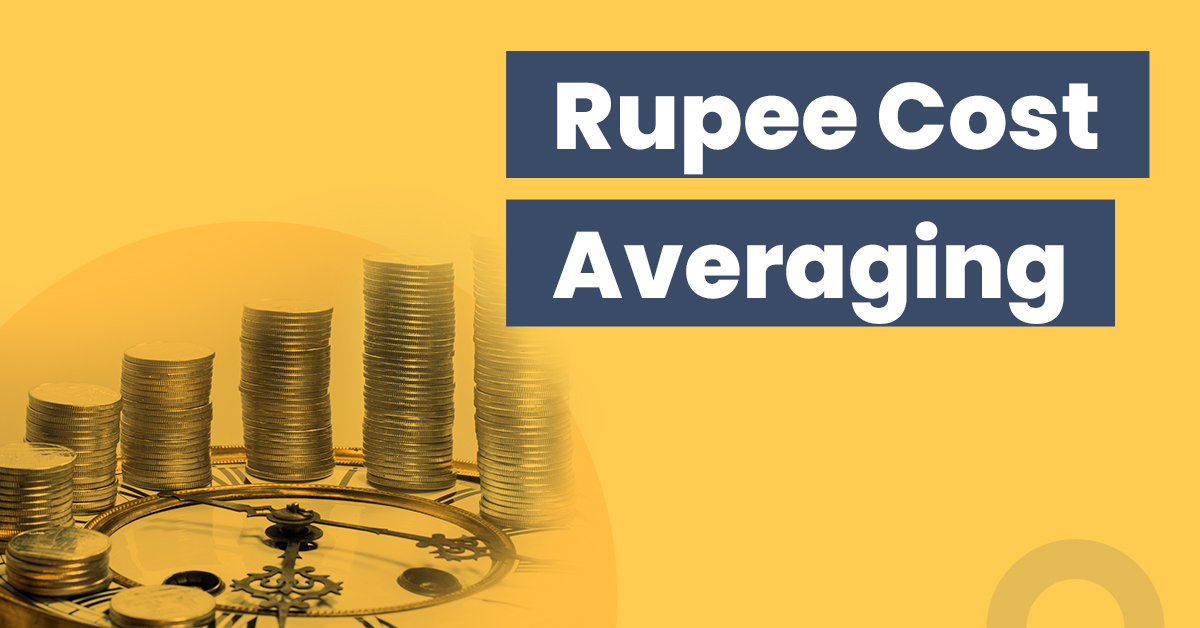What Is Rupee Cost Averaging and How Does It Work?


A Systematic Investment Plan (SIP) is one of India’s most popular investment modes. This is due to its capability to beat inflation and offer considerable returns in the long term. One of the most common benefits of SIPs is ‘Rupee Cost Averaging’, which allows investors to profit from market volatility.
The following sections will cover the concept of rupee cost averaging, its characteristics, benefits, uses and working principles.
What Is an SIP (Systematic Investment Plan)?
Before learning about rupee cost averaging, it is essential to know what an SIP is and what it has to offer to an investor.
An SIP (Systematic Investment Plan) is an investment method that enables an individual to invest money in small quantities periodically in mutual funds. This happens via recurring payments. The payment intervals may be weekly, monthly, quarterly, semi-annually or annually.
In an SIP, the payments are spread throughout the investment tenure. Therefore, one does not require a lump sum of money to invest in SIPs. As a result, they are an excellent option for people with low-risk appetites and long-term investment goals.
One can start SIPs from as low as ₹500 per month. This makes them a feasible investment option for those who cannot afford to invest via a lump sum. In addition, regular payments help instil a sense of financial responsibility in the investors.
Next, we will discuss rupee cost averaging in SIPs.
Also Read: Bear Market : How to Invest in a Falling Market?
Concept of Rupee Cost Averaging
Rupee Cost Averaging is a concept based on averaging the cost at which an investor buys units in a mutual fund scheme. More so, it helps make a profit by balancing out the market risks.
When investing via SIPs, a fixed sum of money is invested irrespective of the fund’s NAV per unit – the lower the NAV, the more the number of units purchased and vice versa.
Since the performances of mutual funds are reliant upon the equity markets, they are subject to volatility and risk. Therefore, it is vital for individuals to remain invested even throughout market downfalls to reap the benefits of rupee cost averaging.
Rupee Cost Averaging is based on time commitment and not investment frequency. This means if an investor is able to remain invested throughout a long tenure, they will be able to gain significant wealth.
How Does Rupee Cost Averaging Work?
The working principle of rupee cost averaging is simple. When an investor invests a fixed amount of money at regular intervals, they receive more fund units when the fund’s NAV is low and less when it is high.
SIPs gain significant advantages from rupee cost averaging. Due to the consistent investments made, the investor ends up buying more units at lesser prices and fewer units at higher prices. This helps in reducing the average cost per unit over the investment tenure. Hence, the average unit cost will be less than the average unit sale price.
For a better understanding of how rupee cost averaging works, let us refer to the example provided below.
Suppose an investor decides to put a sum of ₹4,000 each month in an SIP for a tenure of 6 months. The units allocated would be:
| Month | SIP Amount | NAV per Unit | Number of Units Allocated |
| January 2022 | ₹4,000 | ₹56 | 71.42 |
| February 2022 | ₹4,000 | ₹96 | 41.67 |
| March 2022 | ₹4,000 | ₹84 | 47.62 |
| April 2022 | ₹4,000 | ₹68 | 58.82 |
| May 2022 | ₹4,000 | ₹80 | 50 |
| June 2022 | ₹4,000 | ₹60 | 66.67 |
| Months: 6 | Total: ₹24,000 | Average NAV per unit: ₹71.38 | Total: 336.20 |
From the above table, we can see that the total investment is ₹24,000, with the total number of NAV units purchased being 336.30. Hence, the average NAV unit price is ₹71.38.
If the entire amount were invested in February 2022, the number of units bought would be 250, which is significantly less than 336.20.
Hence, rupee cost averaging is crucial in balancing out market fluctuations during the investment tenure. This makes it a cost-effective way of investing in mutual funds.
Also Read: Bear Market: Meaning, Phases, Signs & Causes
Features and Benefits of Rupee Cost Averaging
The following are some of the advantages of rupee cost averaging.
- Helps in Wealth Generation: Even though investing in mutual funds is subject to market risks, rupee cost averaging provides a systematic approach to building wealth in the long term.
- Averages out the Unit Costs: As discussed previously, the main benefit of rupee cost averaging is that it averages out the cost of purchasing units and, thus, provides stable returns.
- Reduced Investment Complexity: Timing investments based on market conditions can be a difficult task, even for experienced investors. Rupee cost averaging reduces the effect of short-term market fluctuations on your investment, making investing simpler.
- Removes the Need for Regular Monitoring: It removes the need for regular market monitoring. This is a huge benefit since many people do not have the time required to monitor markets.
- Instils Financial Responsibility: It helps instil a sense of financial responsibility within investors. It makes it easy for investors to ensure they remember to invest regularly.
- Reduces Losses from Investments: Rupee cost averaging prevents beginner investors from investing based on predictions, which can turn out to be wrong. Investors can also use it to minimise losses during market downfalls.
Also Read: Compare FD Interest Rates for 1 Year
Uses of Rupee Cost Averaging
The following are some additional uses of rupee cost averaging:
- In dividend reinvestment plans, rupee cost averaging helps in the calculation of the particular amount one must invest over a time period.
- It works well both in volatile markets and bull markets.
- Rupee cost averaging behaves as a safety net against market volatility in equity investments.
Are SIPs Helpful in Bull and Bear Markets?
The concept of rupee cost averaging works best in volatile markets as it helps to minimise losses. Moreover, as SIP investments ensure that you purchase fewer units in bull markets, you end up buying fund units at a lower average price.
In bull markets, the price of a stock continuously increases over a time period. However, even during such times, there may be short temporary downturns. Investing in small amounts during these downturns helps in reducing aggregate costs.
Rupee cost averaging is really useful during such downturns as it makes you purchase less when prices are high and more when prices reduce.
Final Word
Investing in SIPs offers the benefit of rupee cost averaging, which creates financial discipline in your life. It helps in reducing speculations and automates the investing process. The returns gained from investing this way are achieved with less effort and more consistency. It is a necessary tool in unpredictable markets.
Frequently Asked Questions
Does rupee cost averaging have any limitations?
Rupee Cost Averaging is a valuable strategy for buying. However, it does not help in selling. Also, it is not helpful for bearish market trends since it would bring no profit to the investor. It also does not help in determining the investing intervals.
What are the main investment methods in mutual funds?
There are two main investment methods in mutual funds, which are; via lump sum and SIP. The SIP method usually takes advantage of rupee cost averaging due to the regular investments made over a specific tenure.
What is the primary benefit of rupee cost averaging?
The primary benefit of rupee cost averaging is that it helps the investors get maximum benefits out of their investment. This is because it averages out the overall cost and keeps it less than the average sale price of NAV units. Hence, it helps in avoiding the bad effects of market volatility.




